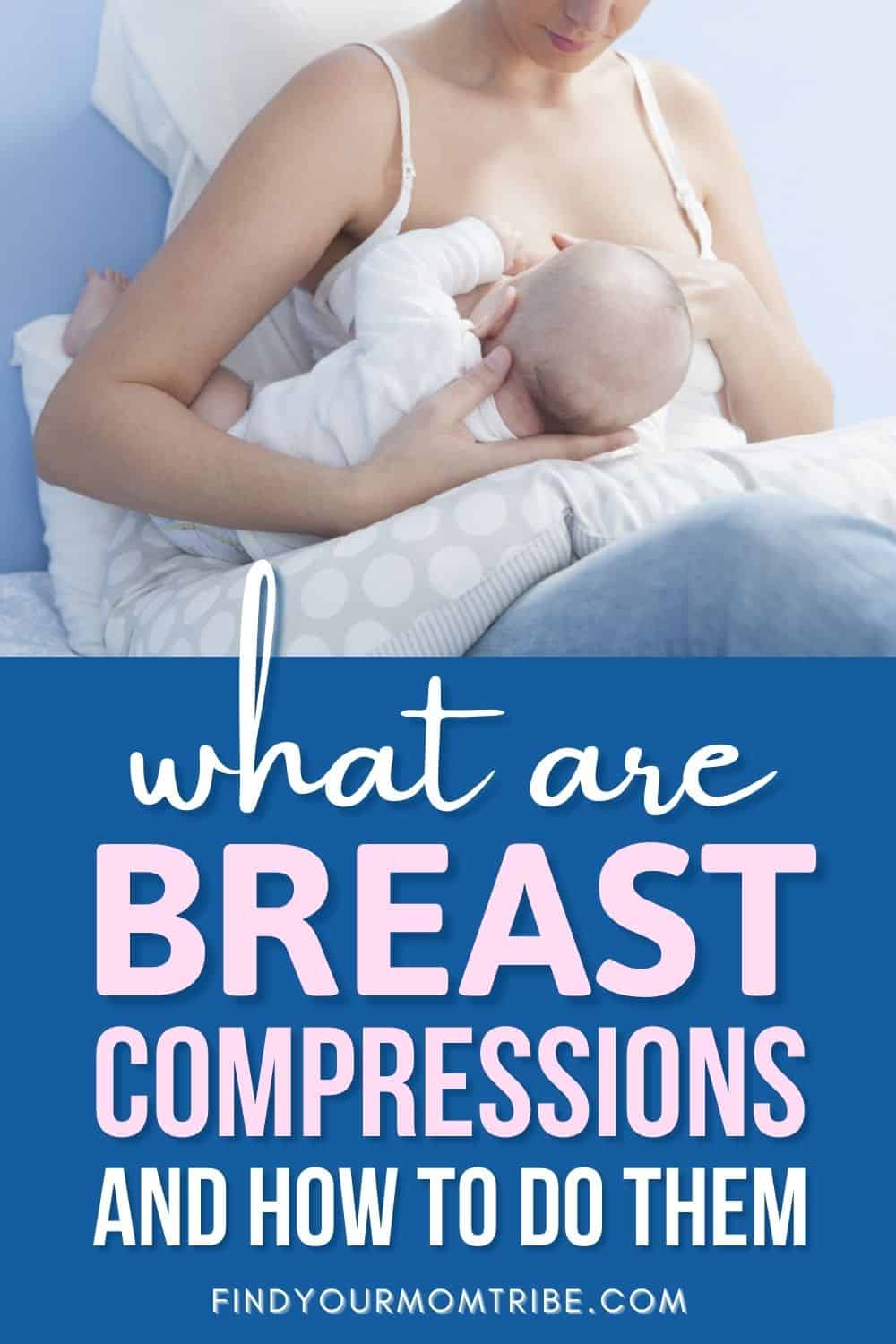If you’re a breastfeeding mother, you’ll know there’s nothing more frustrating than realizing your baby isn’t getting enough milk during a feed. But, with the help of breast compressions, you can solve this problem easily.
Breast compression is a straightforward technique that involves using the fingers to gently squeeze the breast, which compresses the milk ducts and simulates letdown, allowing your little one to get a full feed.
If breastfeeding is going well and your baby is gaining weight at the expected rate, then there’s no need to use this technique.
But if you find nursing to be a struggle, you’ll find compression to be very beneficial. For example, if your baby tends to fall asleep mid-feed, you can compress your breast to gently remind her to begin nursing again.
Moms who are experiencing soreness or cracking in their nipple area can use compression to shorten the length of a nursing session, while still giving their baby enough milk.
Breast compression is also an excellent remedy for poor milk supply because it allows you to completely empty your breasts, which sends a signal to your body to start producing more milk, so you never have to worry about taking lactation supplements.
This technique can also be applied when you have mastitis or a blocked duct, so you should learn how to do it even if nursing is currently going well.
Read on for a step-by-step guide on how and when to properly perform breast compression.
What Are Breast Compressions?

Breast compressions are a very simple breastfeeding trick that helps you express more breast milk, allowing your baby to get a full feed during a nursing session.
To compress your breast, you need to squeeze it using your fingers, the way you’d squeeze a water bottle, for example. Your thumb should be on the top of your breast and the rest of your fingers should apply pressure from the bottom.
Here is a step-by-step guide for how to do breast compressions:
• First, make sure that your baby has latched well onto the breast and is feeding without problems. If you’re attempting compression for the first time, try to get into a comfortable breastfeeding position.
• Feed your baby as usual until you notice that her sucking has subsided and she is no longer actively feeding.
• Use your free hand to squeeze your breast. Your thumb should be pressing down from the top of the breast and the other four fingers should squeeze from the bottom. You should apply just enough pressure so as to squeeze out more milk, but you shouldn’t feel any pain.
• To prevent your baby from unlatching, your fingers shouldn’t be too close to your nipple.
• While your baby is feeding, keep compressing your breast so as to ensure the consistency of the milk flow.
• After your breast is fully drained, switch over to the other one and repeat the process
Keep in mind that this is not the only technique you can use for compression. With time, you’ll get a feel for what works best for you, so feel free to adjust your hand positioning in the way you find most comfortable and effective.
When Should You Use Breast Compressions?

Compressing your breast to express more milk is not strictly necessary, but it can be very helpful. If you aren’t having any problems with nursing, and your little one is growing at a healthy rate, then you don’t have to do it at all.
However, it can be beneficial in a number of different scenarios.
Here’s a brief overview:
• Poor infant weight gain.
• You have a low milk supply.
• You have mastitis.
• Your baby has problems with latching properly.
• Your baby frequently falls asleep mid-feed.
• You’re experiencing sore or cracked nipples.
• You use a breast pump and want to pump faster.
When it comes to breastfed babies, one of the biggest concerns new moms have is that their baby isn’t getting enough milk. Sometimes these worries are unfounded and the baby is growing well, but if she’s not gaining weight, then you can try applying gentle pressure to your breast to improve the flow of milk.
Performing this technique at the right time can ensure you are breastfeeding for as long as possible, and prevent you from having to mix formula and breast milk to supplement your baby’s diet.
Another scenario where breast compression is beneficial is when your milk supply is low. I’m sure you know by now that milk production works on a supply and demand basis. The more milk you express, the more milk your body produces.
As a result, your body will produce less milk if your breasts aren’t fully drained after a feed, keeping you in a low supply cycle that’s hard to escape. Compressing your breasts will ensure this doesn’t happen.
Mastitis, an infection that can lead to painful breastfeeding, is common among nursing moms. As part of the treatment, you should keep feeding your baby from the affected breast, and compressing it in order to clear the blocked duct that led to the infection.
This will also help protect your milk supply as you recover.
It’s normal for a baby to fall asleep after a feed. After all, one of the biggest benefits of nursing is that it helps soothe babies quickly, but if your baby nods off too soon and doesn’t get enough milk, then you can apply breast compressions to gently wake her back up.
In the early days of motherhood, when a new mom first begins to breastfeed her baby, it’s not unusual to experience sore nipples or even cracking of the nipple and areola.
Although this can be painful, this issue is only temporary, and breast compression can make the nursing sessions shorter, while still ensuring your baby gets enough milk.
It’s a similar scenario while using a breast pump. When you’re trying to pump milk without your baby, it can be difficult to encourage letdown or get the milk to flow as quickly as it does when your baby is latched on to your breast.
What’s more, a lot of mothers take breaks at work to pump, and it’s important for them to finish as quickly as possible so they can get back to work. With a bit of compression, you can make the entire process much quicker!
Other Benefits Of Breast Compression

As well as ensuring a healthy supply of milk and allowing you to power through nipple pain, without affecting the amount of milk expressed while your baby feeds, compressing your breasts also has other benefits.
Firstly, it can help your child ingest more hindmilk, which is expressed at the end of the feed and contains more calories and fat than foremilk, which is expressed at the beginning of a feed and is less calorie-rich. Sometimes a baby stops feeding before getting enough hindmilk.
By compressing your breast, you can make sure that your little one gets all the calories she needs to continue her growth.
Compression is also important to help your baby get more colostrum when you first start breastfeeding. This is the first type of milk your body produces, and it contains important nutrients to help your baby ward off infections and strengthen their immune system.
Unfortunately, many moms struggle with nursing over the first few days after giving birth, which results in the baby not getting enough colostrum. With compression, you’ll ensure that your little one gets all of the vital nourishment she needs.
Additional Tips On Getting Your Baby To Drink More Milk

If you’re looking for advice on how to correctly compress your breasts, chances are you’re already having some trouble with nursing your baby or getting her to drink enough milk.
Nursing is not always smooth sailing and there are several things to take into consideration if your baby isn’t getting enough milk from your breasts.
The first step to ensuring your baby gets a full feed is to check whether she has a good latch, which allows the baby to drink plenty of milk throughout the entire nursing session, and not just when your milk is flowing freely.
One of the signs of a poor latch is sore nipples, as well as a baby who nurses for very long periods of time but actually drinks very little milk.
When a baby is properly latched, feeding won’t hurt. In addition, your baby’s mouth will almost entirely cover your areola and you might be able to feel the baby’s chin against your breast.
An international board-certified lactation consultant (IBCLC) can offer you tailored breastfeeding support in this instance and pinpoint the exact issue.
Finding a good nursing position is also very important for making nursing a good experience for both you and your child.
Another common mistake new moms make is to breastfeed on a schedule, rather than on demand. Your baby will show signs of hunger, and you should look out for those cues and feed her when she needs it. Feeding on demand also maintains your supply of milk.
If your baby doesn’t wake up to nurse, then you should rouse her from her sleep and offer her your breast. Get in touch with your health care provider if you find it hard to wake your little one up.
Of course, feeding on demand can be challenging for mothers, so it’s important to have a good support network to help you get enough sleep and stay healthy (both physically and emotionally) during this difficult time.
If breastfeeding exclusively isn’t going well, you can try using a breast pump to express more milk. Pumps can be an excellent ally on your nursing journey, and I recommend pumping any leftover milk after your baby stops feeding.
This way, you can bottle-feed your baby the rest of the milk while also fully draining your breasts.
Depending on your needs and your budget, you can get an electric or a manual pump, although many moms purchase both in case the electric one malfunctions.
Regarding the use of pacifiers for breastfed babies, parents are divided when it comes to deciding whether they do more harm than good. But if you’ve been struggling with breastfeeding, it’s best to avoid pacifiers altogether.
Instead, try comfort nursing , which has the same soothing effects on your child and also boosts your milk production.
If your milk supply is the only issue, you can always rely on lactogenic food for help. Also known as galactagogues, moms have found ways of adding foods like these to cookies, brownies, and even smoothies, so you can easily incorporate lactation snacks into your diet.
Finally, you shouldn’t hesitate to consider supplementing your baby’s diet with baby formula. Although breast milk is the healthiest option for your baby, formula is a safe alternative that will provide your little one with all the nutrients they require.
There are many different types of baby formula, including organic and hypoallergenic options, so you’ll be able to find something that will suit your baby.
The Bottom Line
When nursing doesn’t go as you planned, it’s easy to start feeling mommy guilt and that you must be doing something wrong. But you must remember that learning how to breastfeed your baby is a process, and it can be affected by a number of factors outside your control.
Luckily, you can use breast compressions as a solution for a variety of nursing complications, especially if you’re experiencing soreness and pain, as this technique allows you to shorten the length of a feed without compromising the amount of milk your baby gets.
By following the simple steps outlined above, you’ll quickly learn how to apply gentle pressure to your breast to increase the flow of milk and prevent a low milk supply!
Like this post? Please share or pin it for later. You can also stay in the loop and follow us on Facebook, Instagram or Pinterest.

This post contains affiliate links. Please see our full disclosure for more info.

